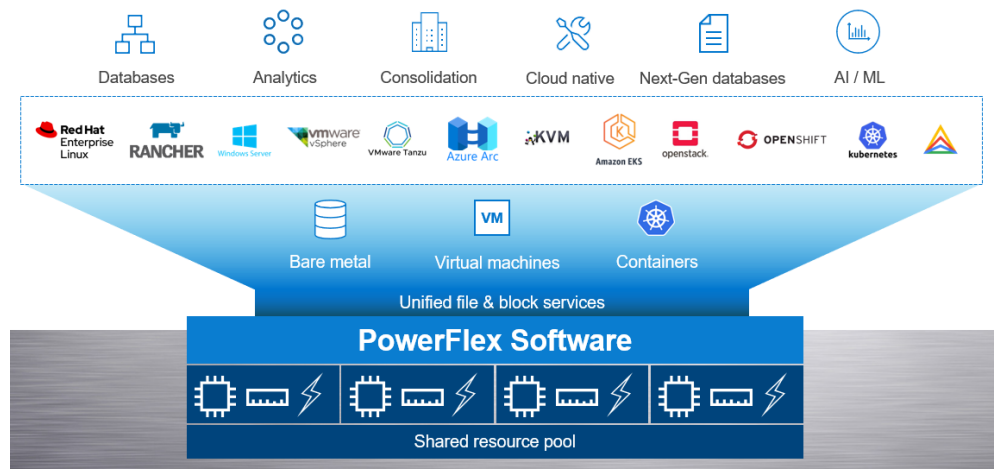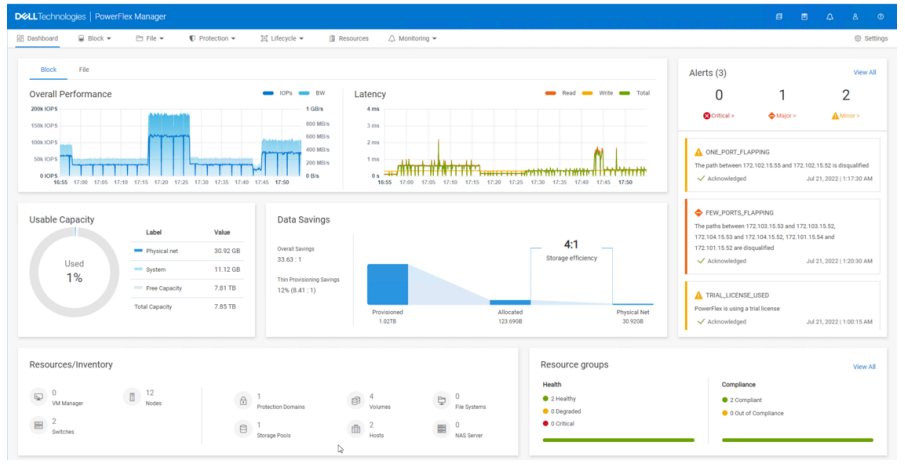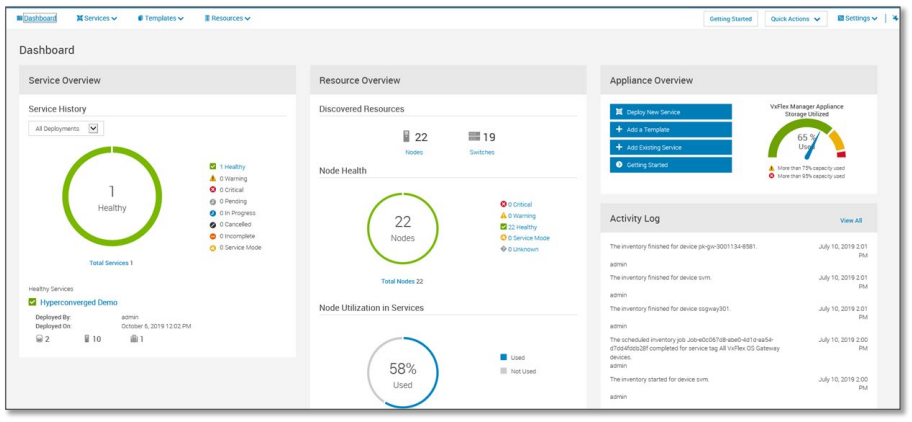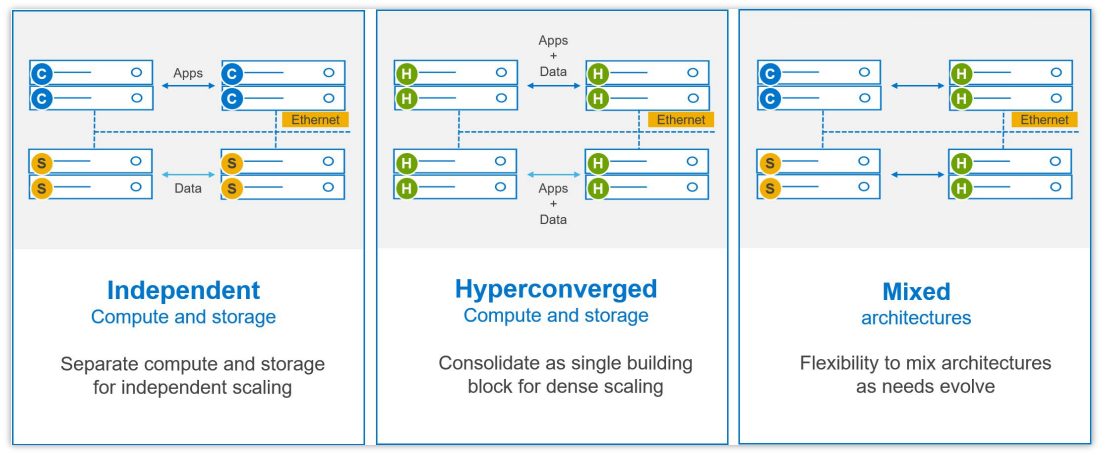Overview:
Dell PowerFlex software-defined infrastructure is a comprehensive, adaptable, and reliable solution that helps businesses modernize their IT infrastructure, increase agility, and meet the demands of modern workloads. With its exceptional performance, scale, and ability to consolidate diverse workloads, PowerFlex instills confidence in your infrastructure to securely deliver under extreme requirements and enables businesses to remain competitive and respond quickly to changing conditions.
Uncompromising performance and density for data center productivity and scale
Benefit from scalable storage performance and data set processing with the PowerEdge R750 server. This 2U, 2-socket platform brings you scalability and performance to adapt to a variety of applications. Choose up to 24 NVMe drives, or a total of 32 x 2.5” or 18 x 3.5” drives. As you scale your deployments, scale your productivity with embedded intelligence and automation from iDRAC9 and the entire OpenManage portfolio designed to simplify the IT lifecycle from deployment to retirement.
Ideal workloads:
- Software-defined storage
- Big Data server
- HPC
- Service providers: data tier
Maximum Flexibility
Achieve extreme business agility, exceptional performance, and scale, and consolidate diverse workloads with Dell PowerFlex

Extreme Business Agility
Versatile architecture with flexible deployment options and automation helps adapt to dynamic business needs

Exceptional Performance and Scale
Deliver unparalleled, reliable performance on a massive scale

Unprecedented Consolidation
Optimally run diverse applications and operating environments on a common infrastructure
A Unified, Modern platform
Software-defined approaches provide compelling choices to deliver this organizational agility. It allows organizations to automate, hence ensuring application requirements are automatically met. Additionally, ease in management allows organizations to utilize personnel efficiently. Also, they combine industrystandard hardware with software to pool and manage resources, thereby optimizing resource allocation. When selecting a software-defined platform, there are some critical aspects to consider:
- The platform must support diverse workload needs such as multiple operating systems, hypervisors and container orchestration platforms, as well as distinct scaling needs and specific data services.
- It must enhance simplicity and agility of the environment by adopting standards and automation.
- It must deliver stringent SLAs predictably and do so at scale. It also must be able to offer enterprise reliability, security, and critical data services.
PowerFlex: An unbounded adaptable Software-Defined Infrastructure
Dell PowerFlex, a software-defined infrastructure, provides a solid foundation for the customers for their IT infrastructure modernization. The journey begins with unconstrained consolidation as customers can combine disparate, heterogeneous workloads onto a common platform, maximizing TCO savings. PowerFlex offers a rich out-of-the-box toolset that includes PowerFlex REST API, Dell Container Storage Modules (CSM) and CSI drivers, and PowerFlex Ansible modules, that help streamline operations and boost business agility. Finally, software-driven storage optimization ensures unrestricted IO and throughput performance with submillisecond latency and linear scalability to 1,000s of nodes. Such fundamental differentiators continue to allow customers to optimize their outcomes, whether modernizing a highperformance database or consolidating large application landscapes.
Modernize without limits
PowerFlex is a powerful software-defined infrastructure platform for customers at any stage of their modernization journey. It unifies the delivery of block and file storage, and compute resources in an engineered integrated system while supporting a wide range of operating environments on a common platform. It supports multiple container management and hyperscaler environments while simplifying workload and infrastructure coordination across your on-premises and cloud assets. PowerFlex also offers NVMe/TCP connectivity, giving customers an option to utilize industry standards. These capabilities empower organizations to optimally consolidate a diverse set of workloads with varying requirements and operating environments and drive transformational TCO savings.
Automate for agility
PowerFlex is engineered to streamline operations and boost agility with intelligent software-driven automation. PowerFlex Manager, a unified management toolset for PowerFlex systems, simplifies IT Operations Management (ITOM) and Life Cycle Management (LCM) tasks by providing extensive automation. It enables automated deployments and expansions with minimal hands-on time for the IT team, letting them focus on other strategic initiatives. Further, a rich out-of-the-box toolset including PowerFlex REST API, PowerFlex Ansible modules, and Dell Container Storage Modules (CSM) and CSI drivers enhance DevOps productivity and IT agility. Lastly, Dell CloudIQ intelligent insights simplify monitoring of distributed multi-location PowerFlex deployments by providing a seamless cloudbased AIOps mechanism.
Optimize your outcomes
PowerFlex is designed from the ground up to deliver consistent predictable outcomes at large scales for your most-demanding missioncritical environments. It is optimized for a wide range of validated workload solutions ranging from traditional relational databases and modern cloud-native NoSQL databases to throughput-intensive analytics workloads.
The architecture delivers massive performance for I/O and throughput-intensive workloads by aggregating resources across many nodes while optimizing data path and placement to deliver the best outcomes. Mission-critical applications running on PowerFlex deliver millions of IOPs at sub-millisecond latency without requiring massive infrastructure build-out, scale the performance linearly to 1,000s of nodes and ensure 99.9999% availability with real-life workloads. Additionally, the software-driven approach provides adaptability, enabling customers to quickly scale their infrastructure to address specific resource bottlenecks and reconstruct and recompose their resource pools to address changing seasonal or long-term requirements.
Features:
PowerFlex Software-Defined Infrastructure
PowerFlex is an unbounded software-defined infrastructure that maximizes IT ecosystem flexibility. It provides a solid foundation for the customers for their IT infrastructure modernization journey. Capabilities such as unified block and file storage, and broad OS, hypervisor, platform support flexibility help consolidates disparate, heterogeneous workloads onto a common platform. Additionally, PowerFlex is designed to automate for agility with a unified management toolset, PowerFlex Manager, that simplifies IT operations and lifecycle management with extensive automation capabilities. Finally, software-driven storage optimization ensures extreme workload results, delivers linear scalability, and enables extreme consolidation without performance degradation, allowing customers to optimize their outcomes and meet extreme SLAs.
Modernize without limits
PowerFlex offers extreme flexibility to meet the diverse and rapidly evolving needs of modern enterprises. It offers unprecedented choice for customers to architect their mission-critical IT environments. Mix and match storage, compute and HCI nodes in a dynamic deployment, allowing users to scale storage and compute resources together or independently, one node at a time, as needs dictate.

The platform can also support a broad range of operating environments – bare metal operating systems, hypervisors as well as container platforms – simultaneously with a unified infrastructure platform and management. By allowing you to flexibly mix these architectures in a single deployment, PowerFlex enables you to deploy, scale, and evolve all your applications to meet your business objectives.
Automate for Agility
PowerFlex is engineered to streamline operations and boost agility with intelligent software-driven automation. PowerFlex Manager, a unified management toolset for PowerFlex systems, simplifies IT Operations and lifecycle management tasks by providing extensive automation that reduces administrative time. Further, a rich out-of-the-box toolset including PowerFlex REST API, PowerFlex Ansible modules, and Dell Container Storage Modules (CSM) and CSI drivers enhance DevOps productivity and IT agility. Lastly, with CloudIQ, PowerFlex leverages an AI/ML-based approach to infrastructure monitoring and management, ensuring simplicity and consistency at scale.

Consistent Predictable Outcomes
PowerFlex is designed from the ground up to leverage industry standards and software-driven infrastructure optimization. The architecture delivers massive performance for I/O and throughput-intensive workloads by aggregating resources across many nodes while optimizing data path and placement to deliver the best outcomes. Mission-critical applications running on PowerFlex deliver millions of IOPs at sub-millisecond latency, scale linearly and ensure 99.9999% availability with real-life workloads. Additionally, the software-driven approach provides adaptability, enabling customers to quickly scale their infrastructure to address specific resource bottlenecks and reconstruct and recompose their resource pools to address changing seasonal or long-term requirements.

Flexible Deployment Topologies
PowerFlex’s extreme flexibility meets the diverse and rapidly evolving needs of modern enterprises, offering unprecedented choice for customers to architect their mission-critical IT environments. Mix and match storage, compute, and HCI nodes in a dynamic deployment, scaling storage and compute resources together or independently, one node at a time, as needs dictate.
The functional character of a node is determined primarily by the installation/presence of software services running on a node. However, PowerFlex nodes are configured and purchased as “storage,” “compute,” or “HCI/hyperconverged” nodes. This reflects the type and quantity of resources in the node, ensuring that resources are suited to the expected usage. For example, storage nodes have less RAM and compute nodes usually have no capacity disks in them.

PowerFlex Consumption Options
With PowerFlex, you have choice and flexibility in how you choose to consume the PowerFlex architecture:
- PowerFlex rack is a fully engineered system with integrated networking. It is designed to simplify deployment and accelerate time to value.
- PowerFlex appliance is a flexible solution with a small starting point and massive scale potential. PowerFlex appliance provides a broad choice of supported networking with either full or partial network automation.
- PowerFlex custom nodes have the same performance and scale potential but leave the network management and hardware life-cycling up to the user.
- Public cloud – powering APEX Block Storage. This is a supported software-only deployment of the softwaredefined storage layer on recommended compute instances (with attached storage) in Amazon Web Services or Microsoft Azure. Only the MG data layout and “independent (2-layer)” block architectures are supported. Fault Sets may be used to distribute the cluster across multiple Availability Zones, thereby improving resiliency even to disruptions with an AZ. Native asynchronous replication may be used to migrate data between cloud and onpremises PowerFlex systems, or to establish cloud-based BC/DR data protection schemes.
PowerFlex is also available with OpEx-based consumption options with APEX Custom Solutions. Customers can choose between APEX Flex on Demand and APEX Datacenter Utility based on their unique requirements.
Technical Specifications:
| |
PowerFlex R650 |
PowerFlex R750 |
PowerFlex R6525 |
PowerFlex R7525 |
| Chassis |
1 RU |
2 RU |
1 RU |
2 RU |
| CPU |
3 rd Gen Intel Xeon |
3 rd Gen AMD EPIC |
| CPU sockets |
Two |
Two |
Two |
Two |
| CPU cores (total) |
16 – 80 |
16 – 80 |
16 - 128 |
16 - 128 |
| CPU frequency |
2.00 GHz - 3.60 GHz |
2.00 GHz - 3.60 GHz |
2.00 GHz - 3.70 GHz |
2.00 GHz - 3.70 GHz |
| RAM1 |
256 GB - 8192 GB |
256 GB - 8192 GB |
256 GB - 4 TB |
256 GB - 4 TB |
| All flash storage capacity |
76TB SAS
38TB SATA
76TB NVMe |
128TB SAS
92TB SATA
128TB NVMe |
Diskless |
Diskless |
| Drive bays |
10 x 2.5” |
24 x 2.5” |
Diskless |
Diskless |
| NVDIMM + RDIMM Support |
Yes |
Yes |
No |
No |
| Boot/OS solution |
480 GB SATA M.2 (RAID1) “BOSS-S2” |
| Nvidia GPU Options |
A2, T4 |
A100, A40, A30, A16, A10, A2, T4, L40 |
A2, T4 |
A100, A40, A30, A16, A10, A2, T4, L40 |
| PowerFlex network connectivity (standard 4x 25Gb) |
Mellanox ConnectX-5 OCP
Mellanox ConnectX-5 PCIe
Mellanox ConnectX-6 PCIe |
| Management port |
iDRAC 9 Out of Band Management |
| Min Nodes Per Cluster (Two-Layer Configuration) |
4 Storage Only nodes minimum (6 or more recommended),
1 to 3 Compute Only nodes (depending on host OS) |
| Min Nodes Per Cluster (HCI Configuration) |
4 HCI Nodes minimum (6 or more recommended) |
| Scaling Increments |
1 Node (HCI, Compute Only or Storage Only)2 |
| PowerFlex Manager Management Node Requirements3 |
Jump Server: 8GB RAM, 2 vCPU, 320GB storage
SRS: 4GB RAM, 2 vCPU, 16GB storage
PowerFlex Manager: 96GB RAM, 48 vCPU, 1.95TB storage
CloudLink (optional): 18GB RAM, 12 vCPU, 192GB storage
(These are all supplied as virtual machines) |
| Management Switches4 |
Cisco Nexus 3172TQ, Cisco Nexus 31108TC-V, Cisco Nexus 92348GC-X, Dell S4148T-ON |
| Access or Leaf Switches |
Cisco Nexus 3132QX, Cisco Nexus 3164Q, Cisco Nexus 93180YC-EX, Cisco Nexus 93180YC-FX, Cisco Nexus 93240YC-FX2, Cisco Nexus N93360YC-FX2, Dell S5048F-ON, Dell S5248F-ON, Dell S5296F-ON5, Dell S5224F-ON‡ , Dell S4148F-ON5 |
| Aggregation or Spine Switches |
Cisco Nexus 9236C, Cisco Nexus 9336C-FX2, Cisco Nexus 9364C-GX, Cisco Nexus 9364C-GX, Dell S5232F-ON |
| Fully redundant power supplies |
800W 100-240Vac / 240Vdc
1100W 100-240Vac / 240Vdc
1400W 100-240Vac / 240Vdc
1100W 48-60Vdc |
800W 100-240Vac / 240Vdc
1100W 100-240Vac / 240Vdc
1400W 100-240Vac / 240Vdc
2400W 100-240Vac / 240Vdc |
800W 100-240Vac / 240Vdc
1100W 100-240Vac / 240Vdc
1400W 100-240Vac / 240Vdc
1100W 48-60Vdc |
1100W 100-240Vac / 240Vdc
1400W 100-240Vac / 240Vdc
2400W 100-240Vac / 240Vdc |
| Redundant cooling fans |
8 |
6 |
8 |
6 |
| Physical dimensions |
H: 42.8mm
W: 434.0mm
D: 751 mm
Wgt: 21.2 kg |
H: 86.8mm
W: 434mm
D: 678.8mm
Wgt: 35.3 kg |
H: 42.8mm
W: 434.0mm
D: 751 mm
Wgt: 21.2 kg |
H: 86.8mm
W: 434mm
D: 678.8mm
Wgt: 24.6 kg |
| Ambient operating temperature |
10°C to 30°C
50°F to 86°F |
10°C to 30°C
50°F to 86°F |
10°C to 30°C
50°F to 86°F |
10°C to 30°C
50°F to 86°F |
| Storage temperature range |
40°C to +65°C
-40°F to +149°F |
40°C to +65°C
-40°F to +149°F |
40°C to +65°C
-40°F to +149°F |
40°C to +65°C
-40°F to +149°F |
| Operating relative humidity |
8% to 80% (non-condensing) |
8% to 80% (non-condensing) |
8% to 80% (non-condensing) |
8% to 80% (non-condensing) |
| Operating altitude with no deratings |
3048m approx. 10,000 ft |
3048m approx. 10,000 ft |
3048m approx. 10,000 ft |
3048m approx. 10,000 ft |
1 Adding NVDIMM reduces maximum memory capacity
2 A single node is the minimum scaling required to expand an existing Storage Pool. Creation of a net new Storage Pool requires the addition of a minimum of 3 Storage or HCI Nodes.
3 New PowerFlex appliance deployments include a single-node management controller (with an option for three-node for larger systems). New PowerFlex integrated rack deployments include a three-node management controller. Both PowerFlex Management Controller options are ESXi based.
4 For PowerFlex appliance, the management switch can be “bring your own”.
5 RJ45 only supported on PowerFlex rack
6 PowerFlex appliance only
Solutions & Services:
Dell EMC offers complete end-to-end services
Optimizing the IT lifecycle is vital. Dell EMC has expert services* for all lifecycle phases that save you time and resources, reduce effort, and improve your IT experience.
ProSupport Enterprise Suite
Gain the freedom to focus on your business transformation with the support expertise and insights Dell EMC is known for across the globe. Choose the right support based on the criticality of specific systems with available automated predictive analysis, collaborative third-party assistance and service account management.
ProDeploy
ProDeploy Enterprise Suite helps you get more out of technology starting on day one. Trust Dell EMC experts to lead deployments from basic hardware installations through planning, configuration and complex integrations. Our complete suite of deployment services and professional certifications helps you achieve business outcomes today and tomorrow.
Training
Education Services offers an expansive suite of training services with multiple delivery methods, including instructor-led, self-paced online and virtual instructor-led training. With comprehensive and flexible training programs, we make it easy to ensure your staff has the skills they need to successfully manage and utilize your new technology to its full potential.
Consulting
Consulting services give expert guidance to help you grow, optimize and transform your IT environment at your own pace and budget. We employ a broad range of certified consultants and engineers, backed by program management teams, who can deliver deep technical expertise. We give you the confidence that your project will be done right and on time.


![]()
![]()





